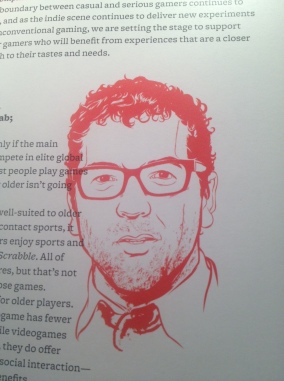The latest issue of Kill Screen Magazine is out – that brainy journal about game culture – and there’s a small piece with my mug in it. The article is about what will happen to games as players become older, and a few game designers, including Randy Smith, Manveer Heir, and myself, are asked for our opinions on the subject.
Kill Screen frames the article as old age potentially being the “kiss of death” for gamers because of the frailties that accompany older age. The other designers mostly mention things like screens for the vision-impaired and hand-eye coordination issues, but I have a different take on the subject. For me, many real-world games enjoyed by older players, such as Bocce Ball, are already as physically intense as a videogame and I see the issue as more about culture than biology.
Here’s a bit from my response. You can read the rest of my answer in Kill Screen, issue 6.



